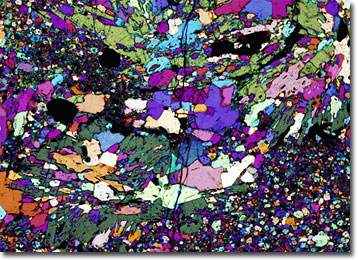Polarized Light Microscopy Digital Image Gallery
Staurolite Quartzite
Quartzite is typically a metamorphic rock mainly or entirely comprised of quartz. Occasionally, however, quartzite may be formed through sedimentary processes.

View a second image of Staurolite Quartzite
Unlike sandstones, which are also composed primarily of quartz, when quartzite is cleaved, it breaks through the grains of quartz rather than through the matrix around the grains. Very hard and massive, quartzite weathers more gradually than many other rocks and, therefore, often stands out of the Earth as hills or mountains. The purest quartzite is white in color, but the rock may also exhibit a variety of other hues, such as pink, brown, blue, or gray, depending on its minor mineral constituents. The purest quartzite is frequently utilized industrially as a silica source, while those that contain impurities are more typically used as a building material.
Staurolite is a neosilicate mineral that is generally reddish-brown to black in color. Common in metamorphic rocks, such as quartzite, staurolite often forms in such a way that its prismatic crystals are twinned, giving them the appearance of a cross. Due to this unusual manifestation, the mineral has been revered as a good luck charm since antiquity when it was referred to as lapis crucifer, or cross stone. Some also call samples of the mineral fairy crosses, and, according to one legend, the tears of fairies that mourned the crucifixion of Christ formed the crosses.
